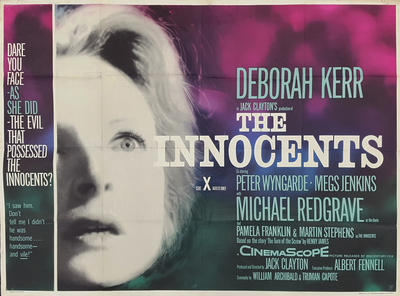Early in The Innocents, Jack Clayton's 1961 gothic horror film, we get a perhaps accidental insight into the appeal of ghost stories like this one. Deborah Kerr plays Miss Giddens, the newly hired governess to two children living in Bly House, their uncle's mansion on a vast estate in the country, nearly alone except for a small domestic staff headed up by Mrs. Grose (Megs Jenkins), the housekeeper.
She knows she's there to replace Miss Jessel, the previous governess, who had become involved with Quint, the valet, and that both are now deceased. Miss Giddens can't suppress her curiosity about the pair, and starts quizzing Grose about them, but the housekeeper doesn't want to talk about the affair.
"They're dead, miss," she tells the governess. "There's no point telling tales of what's done and gone."
It's a good thing for ghost stories and horror films that almost nobody feels the way Mrs. Grose does.
Yarns about ghosts and movies meant to frighten us demand that we imagine things that aren't there, ignore our rational mind, and demand that people tell us tales of what's done and gone. And a really good ghost story will be open about what it's doing, and what it's asking us to do, on the way to giving us a good scare.
The Innocents is based on Henry James' 1898 novella The Turn of the Screw, and takes almost unseemly pleasure in playing with our suspension of disbelief. On her first night in the mansion, Kerr's Miss Giddens is being shown around by Flora (Pamela Franklin), one of her charges – a precocious little girl who tells her new governess that she seems like the sort of person who closes their eyes in the dark.
"I always keep my eyes open in the dark," Flora tells her.
"And what do you see?" asks Miss Giddens, who will soon wish she'd kept her eyes closed, since what we see and don't see will become the issue that drives the film's gradually unfolding tragedy.
Miss Giddens is a spinster – the daughter of a country parson who answers an ad placed by Michael Redgrave's The Uncle. (He has no other name in the story.) He's a bachelor and a worldly man of immense self-regard whose guardianship was forced upon him by the inconvenient death of a younger brother and his wife.
Candour compels him to admit to Miss Giddens – who seems more than a little bit infatuated by this charming cad – that he has no interest in his niece and nephew, but more than enough appreciation of his obligation to them, so her job will be to take on the responsibility for their well-being and spare him any further involvement.

The Uncle's country estate is hardly the decrepit pile of the average ghost story. Cinematographer Freddie Francis' camera is as excited as Miss Giddens to explore it, the widescreen Cinemascope black and white vista taking in the spectacular grounds, with their follies and water features and gardens, the work of Capability Brown and Humphrey Repton. (Sheffield Park in Sussex was being picked by Clayton as the location for Bly House.) Bly is no sinister Gothic monstrosity, teetering on collapse, but a bright and well-kept Gothic Revival manse with a small but apparently industrious complement of maid and gardeners.
It's the children that are unsettling. Little Flora has a morbid streak not uncommon in a bright child, but when her older brother Miles (Martin Stephens) arrives home after being kicked out of boarding school, things start going very wrong.
From the moment she arrives at the estate, Miss Giddens has been hearing voices, and seeing a man watching her. By the time he's joined by the vision of a young woman gazing from a distance, the governess is convinced that the spirits of Quint and Miss Jessel are haunting the place where they died – one by apparent accident, one by her own hand.
Young Miles is an unusually mature and articulate boy, whose solicitous manners take on an unmistakeable flirtation with his governess. He also has moments of unexpected fury and violence – one of which saw him expelled from school. What first appear like pranks being played by the children on Miss Giddens start seeming less innocent to her, and she becomes convinced that the children are possessed by the spirits of the dead valet and governess.
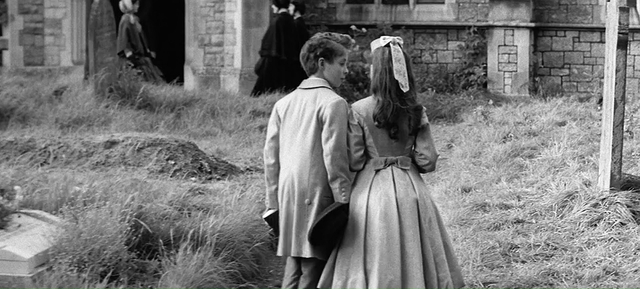
Jack Clayton began his career as a child actor, moving behind the scenes at 14 to start as a "tea boy" at Alexander Korda's Denham Studios in the mid '30s. He worked his way up, doing second unit shooting on The Thief of Baghdad (1940) and assisting David Lean when he was the editor on Major Barbara (1941).
He was an associate producer on two John Huston films, Moulin Rouge (1952) and Beat the Devil (1953), and made his debut as a director with the social drama Room at the Top (1959), which ended up with six Oscar nominations, one for Clayton. He turned down offers to direct Sons and Lovers (1960, directed by Jack Cardiff) and Saturday Night and Sunday Morning (also 1960, and directed by Karel Reisz), considering them too much like his first movie.
Which is how he ended up making a period film, and a ghost story – based on William Archibald's stage version of the James novella, and with a script by Truman Capote and John Mortimer. For modern readers, Henry James' stories are often hopelessly obscured by a thicket of language; the script for The Innocents trims all that away, revealing a stark psychological drama with a pair of minor characters who happen to be dead.
Horror films, like science fiction, were a downmarket affair at the turn of the '60s, awaiting a creative revival that was at least a decade in the future. Hammer Pictures had recently given them a stylized, slightly camp grand guignol makeover, but there was almost nothing like The Innocents in the theatres until Robert Wise released The Haunting two years later.
Henry James wrote The Turn of the Screw as a commissioned job for Collier's Weekly, to produce a ghost story to run in twelve serialized instalments. He was having troubles with money and health, and upon signing the contract began adapting a story told to him by no less than the Archbishop of Canterbury.
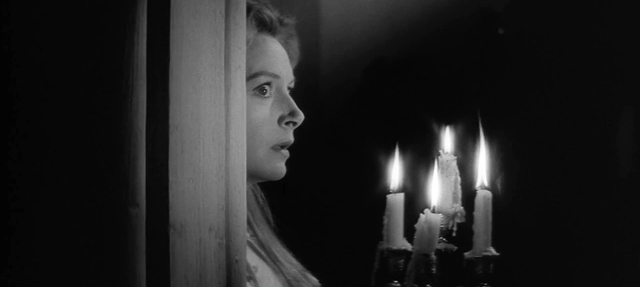
James' story begins, as so many great horror stories do, in a country house on Christmas Eve, where guests are entertaining each other with ghost stories. Their host says that he can outdo one story, "not particularly effective" as the narrator admits, with an even better one. He says that his story, a true one, is "beyond everything. Nothing at all that I know touches it."
"For sheer terror?" I remember asking.
He seemed to say that it was not so simple as that; to be really at a loss how to qualify it. He passed his hand over his eyes, made a little wincing grimace. "For dreadful – dreadfulness."
"Oh, how delicious!" cried one of the women.
He took no notice of her; he looked at me, but as if, instead of me, he saw what he spoke of. "For general uncanny ugliness and horror and pain."
The worst thing about the modern horror film is how explicit they've become. As with sci-fi, the genre produced its masterpieces when it knew that special effects were insufficient to depict the visions – gruesome or awesome – that could so easily be summoned on the page. Restraint was crucial, but restraint is almost wholly absent from modern horror movies, which can paint hellish pictures of unimaginable gore and cruelty with a hyperrealism enhanced exponentially by the money in the production budget and the creativity of the technicians.
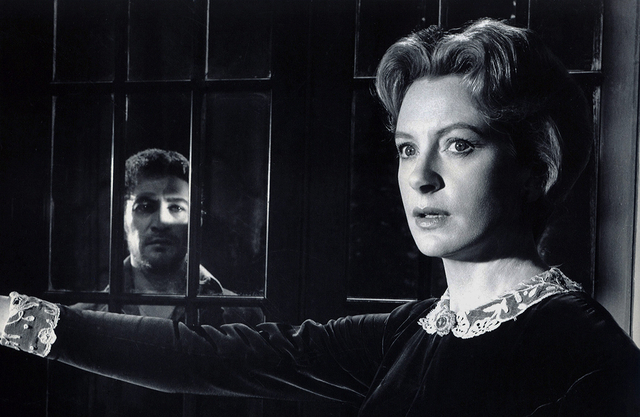
You can't help but envy the audience for the story about to unfold in The Turn of the Screw; they'll experience "dreadful dreadfulness" with mere words and the movie screen in their minds. A film like The Innocents is closest we'll come to that sensation today; more recent retellings of the story, like the 2020 Netflix miniseries The Haunting of Bly Manor, feel no such obligation to subtlety and restraint.
(But it begs the question: Would an 1898 audience find a motion picture like The Innocents, at that point unimaginable to them, just as unbearably explicit? My deep thought for the day.)
The success of The Innocents is the result of everything working as it should. Freddie Francis fills the long, narrow Cinemascope frame with faces and images, separating them on either side of the screen to emphasize their distance and lack of connection, layering dreamlike montages when Miss Giddens and the film begin slipping into delirium.
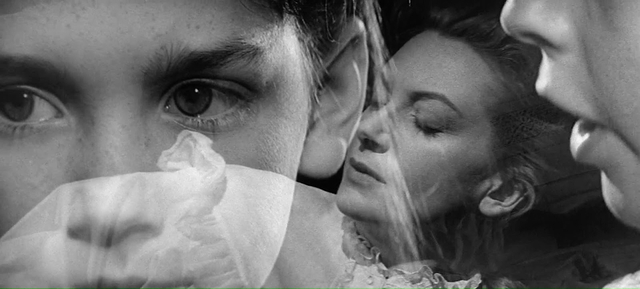
Flora and Miles are among the best performances ever filmed by children; their self-possession is remarkable and necessarily disturbing. But it's Deborah Kerr's governess who really makes the film, and Kerr herself considered Miss Giddens among her best roles.
She's a beautiful woman. "I think you're far too pretty to be a governess," as Miles flatteringly tells her, and that's the tragedy of a woman like Miss Giddens, whose beauty counts for almost nothing in the class system that both advanced the status of the Victorian middle class and confined its most marginal members – dowryless women like Miss Giddens, educated either far beyond or below their economic potential – to a life of genteel service.
One of the best movie blogs on the internet right now is Dreams Are What Le Cinema Is For..., written by Los Angeles cinephile Ken Anderson. His appreciation of The Innocents is also, and quite rightly, an appreciation of Kerr's performance:
"Given how often I've watched The Innocents merely to see the play of emotions across Deborah Kerr's face – some of the most complex appearing in almost imperceptibly brief flashes of brilliance – I, like Kerr herself, am convinced this film is her finest screen performance. With the entire film hinging upon the arc of Miss Giddens' character: from empathetic voice of reason to irrational, possibly unstable fantasist; Kerr moors this ghost story in a gripping emotional realism.
"With no dialogue specifically addressing the source of her character's many 'issues' (the fervency of her devotion to children, the cause of her troubled dreams, the austerity of her existence, her sexual repression/preoccupation) she makes The Innocents as much a film about the dangers of repressed desire cloaked in moral rectitude as it is about the corruption of innocence."
And it's the film's descent from reason to fantasy that makes it horrifying – that makes any ghost story or horror film a waking nightmare if it really works. Kerr's best performances, from Sister Clodagh in Black Narcissus (1947) to Karen in From Here to Eternity (1953) to Hannah in The Night of the Iguana (1964), have a tightly-wound, more than faintly neurotic quality, and it's no better served than in The Innocents.
The first words we hear in the film are Kerr's, over a black screen, telling us that "All I want to do is save the children, not destroy them." It goes without saying that any horror movie that presses such a statement on us so significantly and early will inevitably end by showing how it fails, and how terribly.
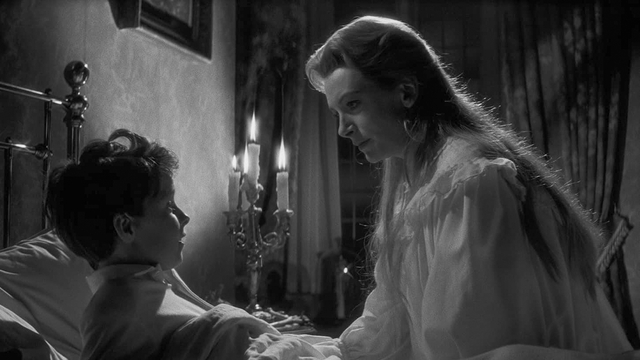
Miss Giddens goes from adoring her charges to being afraid of them, as she conceives of their possession by the baleful spirit of Miss Jessel, and the malevolent one of Quint – wordlessly played by Peter Wyngarde, who more than delivers as the spectre of a man whose cruelty was so substantial as to live beyond the grave.
She tries to explain her sudden harshness and barely concealed hysteria to the children by telling them that "my father taught me to love people. And help them. Help them even if they refuse my help, even if it hurts them sometimes." It's a sentiment that perfectly sums up what we've come to understand (rightly or not) as the principle failing of Victorian moral philanthropy and the colonial project, and it's more than alive in the social engineering projects of today.
Whether Miss Giddens is actually seeing the ghosts of Jessel and Quint, never mind the matter of their possession of Flora and Miles, is at the heart of the horror of The Innocents – Kerr's unreliability as a protagonist, and the ambiguous nature of what we're seeing, compelling as it might be.
This reaches a boiling point when Flora steals away, taking an off-limits rowboat and making her way to a little lakeside Gothic folly. Miss Giddens is certain that the only way to help the children is to get them to talk about whatever happened between them, their old governess, and Quint, and to admit that they can see their phantoms.
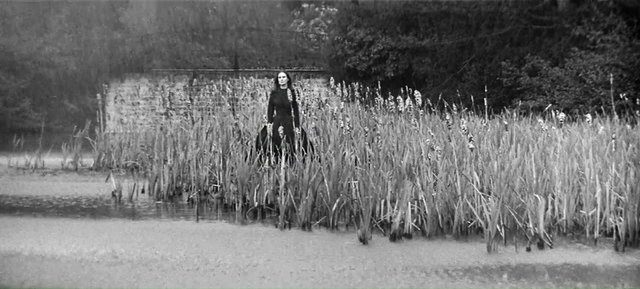
With the ghost of Jessel standing in the reeds on the far shore watching them, Miss Giddens demands that Flora talk about what happened in a growing fury that traumatizes the little girl, reducing her to a shrieking terror that lasts all night, echoing through Bly House. What makes the scene even more unbearable is that, like Miss Giddens, we can see Jessel's black-clad spirit on the pond's edge, while the little girl and Mrs. Grose insist that they can't.
Ken Anderson again:
"The puzzle of the story is compellingly provocative and the whole film is shrouded in a disturbing sense of discordant interactions, but what cemented The Innocents as an enduring favorite (and made watching the film a genuinely frightening experience I was more than happy to repeat) is how its ambiguous structure played with my imagination just as deftly as the shadows and barely heard whispers in Bly House played with that of Miss Giddens."
The failing of second-rate ghost stories and horror movies is that the peak of tension happens when the protagonist or some other character is unable to convince anyone of what they're seeing. Their vindication – when the spectre becomes tangibly real and wreaks havoc on the living – is supposed to provide a kind of catharsis, but it never does, and such films inevitably go downhill from that point.
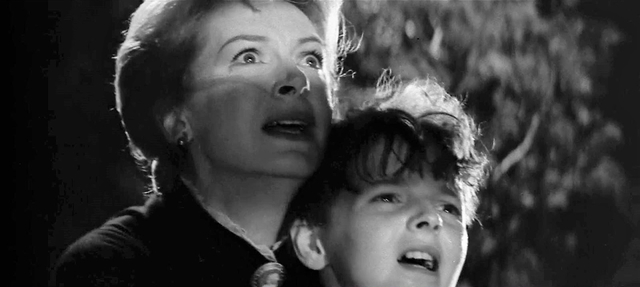
It's easy to dismiss Miss Giddens as mad, and many critical takes on the film do just that, but the fact remains that we can see the same terrible things she does, which makes us, if not complicit, then at least interested bystanders to her delusion. We want to be scared, and so we're happy to go on the ride and accept premises we'd reject in real life – to have what Ken calls that "genuinely frightening experience I was more than happy to repeat."
Because the lasting appeal of the horror movie is a terrible one: to flirt with what might be understood as madness on one hand, or as a vision of a terrible world of chaos nudging alongside our own, whose existence – once acknowledged as real – makes a mockery of what we believe and wrecks our dearest assumptions about life, reason and order.
The thousands of videos made by "paranormal investigators" give us a glimpse of a world where ghosts are real, and ghost stories are the dullest and dumbest entertainment imaginable. The ghost story as an art form only thrives when we all tacitly agree that ghosts don't exist, and any idea that they are must remain imponderable if we still want to enjoy a "genuinely frightening experience."
Mark Steyn Club members can let Rick know what they think by logging in and sharing in the comments below, as access to the comments section is one of many benefits that comes along with membership in the Mark Steyn Club.


